|

Summer 2002 (10.2)
page 25
Thor Heyerdahl
Thor
Heyerdahl's Final Projects
by J. Bjørnar Storfjell, Ph.D.
Visit the new Thor Heyerdahl
Research Center in London directed by Bjørnar Storfjell.
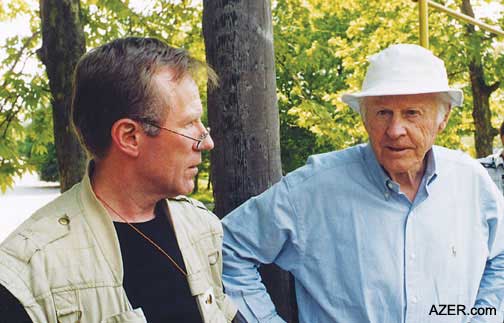
Above: J. Bjornar Storfjell with Thor Heyerdahl
in Azov, Summer 2001. Photo courtesy: Storfjell.
Other articles
by or related to Thor Heyerdahl:
(1) Thor Heyerdahl in Azerbaijan: KON-TIKI
Man
by Betty Blair (AI 3:1, Spring 1995)
(2) The Azerbaijan Connection: Challenging
Euro-Centric Theories of Migration by Heyerdahl (AI 3:1, Spring 1995)
(3) Azerbaijan's
Primal Music Norwegians Find 'The Land We Come From' by Steinar Opheim (AI
5.4, Winter 1997)
(4) Thor
Heyerdahl in Baku
(AI 7:3, Autumn 1999)
(5) Scandinavian
Ancestry: Tracing Roots to Azerbaijan - Thor Heyerdahl (AI 8.2, Summer 2000)
(6) Quote:
Earlier Civilizations - More Advanced - Thor Heyerdahl (AI 8.3, Autumn 2000)
(7) The
Kish Church - Digging Up History - An Interview with J. Bjornar Storfjel
(AI 8.4, Winter 2000)
(8) Adventurer's
Death Touches Russia's Soul - Constantine Pleshakov (AI 10.2,
Summer 2002)
(9) Reflections on Life
- Thor Heyerdahl (AI 10.2, Summer 2002)
(10) First Encounters in
the Soviet Union - Thor Heyerdahl (AI 10.2, Summer 2002)
(11) Voices of the Ancients:
Rare Caucasus Albanian Text - Dr. Zaza Alexidze (AI 10.2,
Summer 2002)
(12) Heyerdahl
Burns "Tigris" Reed Ship to Protest War - Letter
to UN - Bjornar Storfjell, Blair (AI 11.1Winter 2003)
Other articles by or related
to Bjornar Storfjell:
The Kish Church:
Digging Up History - Bjornar Storfjell (AI 8.4, Winter 2000)
Voices
of the Ancients: Rare Caucasus Albanian Text - Zaza Alexidze
(AI 10.2, Summer 2002)
Church
in Kish: Carbon Dating Reveals Its True Age - Bjornar Storfjell
(AI 11.1, Spring 2003)
Since his first visit to the
Caucasus early in the 1960s, Thor Heyerdahl had stored in his
memory the similarities he found between the petroglyphs in Gobustan
near Baku and the petroglyphs in Scandinavia, especially those
in Alta, Norway. Even though this similarity belonged to pre-history
and could not be transferred to later history at the beginning
of the Viking era, Thor nevertheless suspected that there might
be other cultural connective links between the Caucasus and Scandinavia.
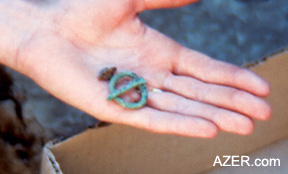  That was the reason for his visit to
the region in the Autumn of 2000. He was on the trail of Odin
(Wotan), the Germanic and Nordic god of the mythologies of the
early sagas. According to Snorre, the Icelandic author of the
Nordic Sagas, who wrote in the 13th century, Odin was supposed
to have migrated from the region of the Caucasus or the area
just east of the Black Sea near the turn of the first century
AD. Thor wanted to test the veracity of Snorre and, consequently,
organized the Joint Archaeological Excavation in Azov, Russia
in 2001. That was the reason for his visit to
the region in the Autumn of 2000. He was on the trail of Odin
(Wotan), the Germanic and Nordic god of the mythologies of the
early sagas. According to Snorre, the Icelandic author of the
Nordic Sagas, who wrote in the 13th century, Odin was supposed
to have migrated from the region of the Caucasus or the area
just east of the Black Sea near the turn of the first century
AD. Thor wanted to test the veracity of Snorre and, consequently,
organized the Joint Archaeological Excavation in Azov, Russia
in 2001.
An ancient fibula, a type of garment
pin, one of the objects found at Thor Heyerdahl's dig in Azov,
Russia.
I met Thor in Moscow on April 21, 2001. He had already contacted
Dr. Sergey Lukiashko of the Institute of Archaeology at the State
University of Rostov-on-Don. Thor had been planning an excavation
at this site because of the peculiar phonology of the place -
name Azov. Snorre speaks of a place called Ashov (read As-hov)
- the sacrificial site of the As tribe. This phonological coincidence
led Thor to start his investigations in Azov, Russia.
I had met Heyerdahl earlier in Azerbaijan in the summer of 2000
while excavating the Kish church [See Storfjell's article, "The
Kish Church - Digging Up History" in AI 8.4, Winter 2000].
Heyerdahl appointed me chief archaeologist for the Scandinavian
team, which was composed of two other Norwegian archeologists
and two Swedish archeologists. For a period of six weeks, we
carried out the excavation with our Russian colleagues.
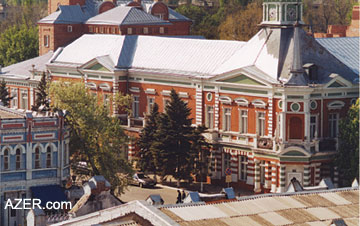  The results of the first season brought
to light more than 35,000 individual pieces of material cultural
remains, which have now all been numbered and registered. Most
of these items would excite only archeologists and offer little
occasion for joy to the uninitiated. I am primarily referring
to broken ceramic vessels whose many fragments filled several
buckets each day. But it is these unglamorous fragments that
yield their secrets about the dates of their creation and help
us to assign dates to the various layers of soil that are being
excavated. The results of the first season brought
to light more than 35,000 individual pieces of material cultural
remains, which have now all been numbered and registered. Most
of these items would excite only archeologists and offer little
occasion for joy to the uninitiated. I am primarily referring
to broken ceramic vessels whose many fragments filled several
buckets each day. But it is these unglamorous fragments that
yield their secrets about the dates of their creation and help
us to assign dates to the various layers of soil that are being
excavated.
Left: Azov Regional Museum in Russia. Work
begun in Search for Odin - Thor Heyerdahl's project - in Summer
2001. Photo: Bjornar Storjfell.
Among the more significant finds were several fibulae - circular
ring-pins used to fasten garments - which can be dated to the
1st-2nd centuries AD. They showed a clear affinity with fibulae
from the Baltic region and would not have been out of place had
they been discovered there. The same can be said about a sword
found in a burial from the same period. After just one season
of excavation, we can demonstrate a certain level of cultural
connectivity between the steppe region of the Black Sea with
the Baltic. It is very likely the great rivers of Russia were
the conveyors of these cultural links, something that puts us
right back into an environment that Thor Heyerdahl was very much
at home with - water.
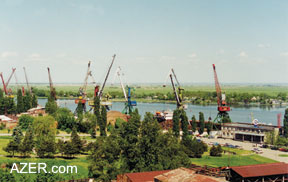  The first season - Summer 2001 - in
this extensive project took place in Azov, Russia. The total
scope of the project envisions several more seasons of excavation
in and around Azov. Then the investigation will move to the Caucasus,
where the As and Van peoples once lived. This is all recorded
in the Norse Sagas, but about 2,000 years before Snorre in Iceland
wrote about these people groups, the Van were referred as a geographical
term in Assyrian contemporary records in the 13th century BC.
The As are identified in contemporary Assyrian records from as
early as the 7th century BC. This evidence warrants continued
research in the Caucasus, not just to test the statements of
Snorre, but to help us understand more about a region that has
figured so prominently as a cultural bridge, early in human history. The first season - Summer 2001 - in
this extensive project took place in Azov, Russia. The total
scope of the project envisions several more seasons of excavation
in and around Azov. Then the investigation will move to the Caucasus,
where the As and Van peoples once lived. This is all recorded
in the Norse Sagas, but about 2,000 years before Snorre in Iceland
wrote about these people groups, the Van were referred as a geographical
term in Assyrian contemporary records in the 13th century BC.
The As are identified in contemporary Assyrian records from as
early as the 7th century BC. This evidence warrants continued
research in the Caucasus, not just to test the statements of
Snorre, but to help us understand more about a region that has
figured so prominently as a cultural bridge, early in human history.
Above: The Port of Azov on the River Don,
ancient Tanais. Credit: Bjornar Storjfell. In Search for Odin
- Thor Heyerdahl Project - excavation team began work in Summer
2001 and continued in Summer 2002.
At age 86, Thor was one of the most energetic persons at Azov.
Each day last summer, he would visit every excavation site -
five in total - scattered throughout the city. We Scandinavians
were excavating in a strawberry garden with the kind permission
of the owner, who decided to forego the berries in favor of ancient
history. At meal times during our discussions, the ideas began
to emerge about how we would carry on Thor's archaeological work.
Half a year later, those ideas of a research center became a
reality.
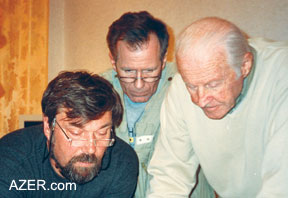  In the meantime, after the excavation,
work shifted to analysis of the finds and the task of writing
up the reports of the fieldwork. Thor continued working on the
manuscript of what was to become his last book. "Jakten
på Odin" (In Search of Odin) was published in Norway
a few months later, in November 2001. (The English version is
scheduled to appear around November 2002.) A couple of days after
Thor returned to his home in Tenerife in the Canary Islands,
following the book launch in Oslo, Norway, I visited him in connection
with writing up reports on Azov. But it seems he had other matters
to discuss. In the meantime, after the excavation,
work shifted to analysis of the finds and the task of writing
up the reports of the fieldwork. Thor continued working on the
manuscript of what was to become his last book. "Jakten
på Odin" (In Search of Odin) was published in Norway
a few months later, in November 2001. (The English version is
scheduled to appear around November 2002.) A couple of days after
Thor returned to his home in Tenerife in the Canary Islands,
following the book launch in Oslo, Norway, I visited him in connection
with writing up reports on Azov. But it seems he had other matters
to discuss.
Right: Sergey Lukiashko, Russian Archeologist,
Thor Heyerdahl and Bjornar Storfjell, Norwegian archeologist,
discussing plans for the Azov dig in Russia 2001.
He had been offered funding for the second season of excavation
in Azov, and in that connection he wanted to establish a research
center. He honored me by asking me to set up the center and then
to direct it; it would be located in England for a variety of
practical reasons.
By the middle of February 2002, the Thor Heyerdahl Research Centre
had become a reality. It was organized and registered at Companies
House in England, and Thor Heyerdahl was the first Chairman of
the Board. Now his widow, Jacqueline Beer Heyerdahl, holds that
position and is eager to oversee the continuation of Thor's work
in Azov, the greater Caucasus and beyond.
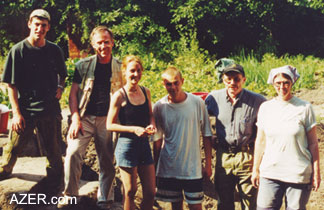 Beyond that, there is a new project
that Thor was planning in Samoa in the Pacific. He had been made
aware of the existence of a pyramidal structure that is thought
to be the largest of its kind in the Pacific. In February 2002,
he visited the site with Jacqueline and started making arrangements
for an excavation to begin in Autumn 2002. Beyond that, there is a new project
that Thor was planning in Samoa in the Pacific. He had been made
aware of the existence of a pyramidal structure that is thought
to be the largest of its kind in the Pacific. In February 2002,
he visited the site with Jacqueline and started making arrangements
for an excavation to begin in Autumn 2002.
Left:
Bjornar Storfjell - 2nd
from left with Scandinavian team working on Thor Heyerdahl's
project in Azov. Russia, Summer 2001. Source: Storfjell
He had wanted Samoa to be his
last project. It was in the Pacific that he had started his long and illustrious
career, and it was there that he wanted to close the last chapter
of his professional endeavors. But April 18, 2002 conspired against him. Thor Heyerdahl, perhaps
the best-known Norwegian of the second half of the 20th century,
died peacefully in his sleep at his family home in Colla Micheri
in Italy, where he had gone to spend the Easter holidays with
the closest members of his family around him. The Norwegian Government
gave him a State Funeral in the Oslo Cathedral on the April 26.
His urn will be placed in the garden of the family home in Colla
Micheri. Even in death, he belonged to the world. He is dearly
missed.
At the time that this article was written, Bjornar Storfjell was the Chief
Executive and Archaeologist of the Thor Heyerdahl Research Centre.
____
Back to Index
AI 10.2 (Summer 2002)
AI Home
| Magazine
Choice
| Topics
| AI Store | Contact us
Other Web sites
created by Azerbaijan International
AZgallery.org | AZERI.org | HAJIBEYOV.com |






 Beyond that, there is a new project
that Thor was planning in Samoa in the Pacific. He had been made
aware of the existence of a pyramidal structure that is thought
to be the largest of its kind in the Pacific. In February 2002,
he visited the site with Jacqueline and started making arrangements
for an excavation to begin in Autumn 2002.
Beyond that, there is a new project
that Thor was planning in Samoa in the Pacific. He had been made
aware of the existence of a pyramidal structure that is thought
to be the largest of its kind in the Pacific. In February 2002,
he visited the site with Jacqueline and started making arrangements
for an excavation to begin in Autumn 2002.